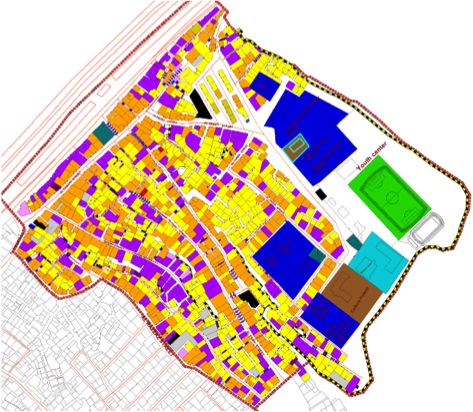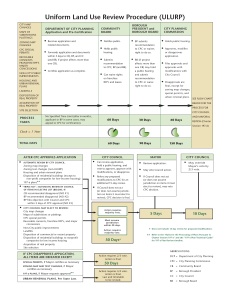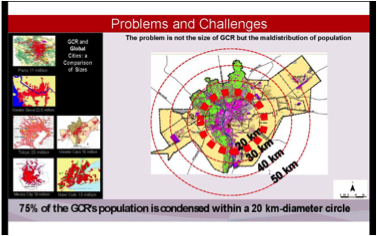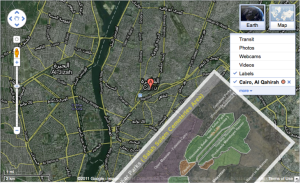Cairo 2050 القاهرة ٢٠٥٠
Cairo 2050 القاهرة ٢٠٥٠
Cairo 2050 is a visioning document created by the former administration to prioritize urban development projects in the Greater Cairo Metropolitan Area. The authors of this website argue the document, if followed, would create social, economic, political and environmental injustice. Our critique can be found below, but please download the original and make your own opinion, then join the discussion on the Blog/Forum.
مشروع القاهرة ٢٠٥٠ عبارة عن وثيقة رؤيوية تم انشاؤها من قبل الإدارة السابقة لتحديد أولويات مشاريع التنمية العمرانية في مدينة القاهرة. واضعو هذا الموقع وجدوا أنه إذا ما تم تنفيذ هذا المشروع فإنه سيؤدي إلى ظلم اجتماعي واقتصادي وسياسي. ويمكنكم الاطلاع على نقدنا للمشروع أدناه ، ولكن يرجى تحميل النسخة الأصلية وتكوين آراء خاصة بك ومن ثم الانضمام إلى المناقشة في المدونة / المنتدى.
Downloads
Download Original Cairo 2050 Document Cairo 2050 vision v 2009 GOPP 12 mb
Download Addendum 1 (link coming soon)
Download Addendum 2 (link coming soon)
Critique of Cairo 2050
Summary of critique
Cairo 2050, if followed, would create more socioeconomic inequality and increase traffic congestion by pushing lower-income residents to the periphery of the city, and reducing the environmental sustainability the city presently has. Moreover this document was created in isolation and is a classic example of outdated top-down planning. Other forms of planning engage the public in a meaningful way at multiple stages of the design and through public participation and review to ensure transparency of all land transactions.
Socioeconomic Critique of Cairo 2050
Cairo 2050 was heavily influenced by real estate developers, reflecting the power of a small business elite in the Egyptian state and government. Cairo 2050 was inspired by visioning excercizes of other cities in the world – such as Sydney 2030, Paris 2020, London 2020, Singapore 2050, Abu Dhabi 2030, Shanghai 2050, and Tokyo 2050- but without much incorporation of the distinct needs of the majority of Cairo’s residents and with little consultation with the city’s residents.

Bulaq now and future? This slide from Cairo 2050 (source: GOPP) shows the Bulaq area transformed into a vast campus of high-end development. Where will these residents go? How will residents and businesses from other areas be able to use the many vital services and industries presently found in the Bulaq if this neighborhood of tens of thousands of families and businesses is transformed into a campus of skyscrapers?
In Cairo 2050, downtown Cairo would be transformed and have skyscrapers and large gardens. These new developments would not contain the capacity to house the large number of people currently living there and just as importantly, with the higher property values, it would not be affordable to the vast majority of the current residents and their families.There are no provisions for what would happen to these families, reflecting that Cairo 2050 largely serves the interests of small elite. The vision also implicitly assumes that many of these areas are not very productive and need to be developed. This assumption is not completely accurate, as there is a great deal of economic activity in Cairo which is undervalued or not counted in official statistics. This ‘informal’ economy is intricately tied to the ‘formal’ economy, however.
Environmental Critique of Cairo 2050
The environmental dimension of the 2050 Plan is most explicitly about the creation of green areas at the expense of informal neighborhoods. The Egyptian authorities have long used environmental arguments to justify tearing down informal areas. The claim that Cairo will be made more environmentally sustainable by adding green space through the displacement of residents from the dense inner core to satellite cities is a fallacy.
It has long been known that urban density is the key to sustainability, the economies of density can be reaped by citizens of all economic classes. Mass transit systems, one of the key avenues to environmental sustainability require density to be economically feasible. Moreover, density means people can walk to and from jobs, the market, and schools.
Building and widening highways and creating satellite cities often makes congestion worse, not better, in downtown Cairo. A systems-based analysis is required, not road contracts that benefit the investors for the road and add little value to Egyptian families struggling to navigate the city. Additionally, while the Cairo 2050 vision includes ideas for a public transit, there is a need for transportation system planning based on an integrated analysis and plan for land use and transportation.
Are informal areas detrimental to the environment?
While many believe so, this is a shortsighted and superficial view of the actual impact to the environment. Experts argue convincingly that hyper density in cities leads to greater energy and resource efficiency (especially for water). Furthermore, some of the popular neighborhoods in Cairo are renown for their recycling activities, which whole areas have actually adopted as their main source of income.
Loss of agricultural land
Another major environmental concern that has impacted the Egyptian authorities attitude towards informal areas has been the loss of agricultural land. Cairo is surrounded by precious and rare cultivable land and much of the expansion of the informal city has taken place as its expense. The main reason for this has been that agricultural land is privately owned, easily parceled and sold (See David Sims book listed in the resources section for more on this). While it is true that this is a significant problem, informal area growth on Agricultural land is a symptom rather than the cause of the problem. The central problem is a lack of affordable housing created by the private and public real estate markets. In Cairo there is an oversupply of housing for the middle and upper classes, with huge amounts of vacant houses. The real estate market must be reformed to incentivize the creation of adequate lower and lower-middle income housing.
Critique of Non-Participatory Process of Cairo 2050
Cairo 2050 was created in an outdated top-down fashion and disproportionately benefited elite real estate interests at the expense of environmental sustainability and economic justice. While some aspects of the plan may have been beneficial, a process which engaged more with the public would have led to better and more just results.
Many other areas in the world, after struggling with older forms of planning, have formalized systems of public engagement and participation in decision-making over land. Some ideas and resources are listed here to begin a discussion on how public participation in decisions regarding land might be structured.
GIZ’s Participation-Oriented Development Programme in Densely Populated Urban Areas
In parts of Cairo, such as Manshiyet Nasser, German Society of International Cooperation’s (GIZ) this program has been effective at translating neighborhood priorities into neighborhood improvements that have a real impact on residents’ lives. A detailed report entitled, Cairo’s Informal Areas Between Urban Challenges and Hidden Potentials (download) can be found on the Cities Alliance website.

Consultative process were used to develop this land use map of a neighborhood in Manshiyet Nasser (source: GIZ). Related participatory processes could be used to develop urban plans that serve the interests of all Cairenes (credit: GIZ))
New York City’s Uniform Land Use and Review Procedure (ULURP)
New York City has a complicated but effective way of making sure there are many checks and balances on land use decisions. The steps of this process are outlined in the diagram below More Info on New York’s ULURP Process here:
http://www.nyc.gov/html/dcp/html/luproc/ulpro.shtml
http://www.nyc.gov/html/dcp/html/luproc/ulrule.shtml
http://www.nyc.gov/html/dcp/pdf/luproc/lur.pdf

New York City has a complicated but effective way of making sure there are many checks and balances on land use decisions (credit: New York City)
Recent publications about participation in governance of land
Land Equity International is a consulting firm specializing in securing land rights and reforming land administration.Some of their relevant publications include:
Land Administration Reform: Indicators of Success and Future Challenges (2006)
Land Governance Assessment Framework Manual (2010)
Check out all of their publications here.
Coming soon: interactive visualizations of Cairo 2050 and Google Maps
يرجى ملاحظة : هذا الموقع هو قيد الانشاء. الصور الجغرافية التفاعلية آتية قريباً
23 Comments
Leave a CommentTrackbacks
- نشرة مرصد العمران
- The Future of Egypt’s New Capital Lies in the Past
- On Ibrahim Mahlab’s Appointment as Prime Minister | Cairo from Below القاهرة من الأساس
- City of the Dead | Revolve Magazine
- Traffic woes in Cairo | لماذا غزة؟ Why Gaza?
- The Egyptian Revolution and Those it Left Behind « Cairo from Below
- Egypt: Among Bulaq’s Ruins in an Unfinished Revolution :: Elites TV
- بولاق: وسط بقايا ثورة مستمرة · Global Voices الأصوات العالمية
- Egypt: Among Bulaq’s Ruins in an Unfinished Revolution · Global Voices
- Going green in a new Egypt « CairoFromBelow
- New UN HABITAT office in Cairo : will it join with activists and stand up against forced evictions? « CairoFromBelow




Hello, its pleasant piece of writing on the topic of media print, we
all be familiar with media is a wonderful source
of data.
Very good writing! But i have one question, do you know the author or creator of Original Cairo 2050 Document you linked at the beginning of the article? Would be thankfull for an answer!
GOPP – the planning institution
Thanks for sharing your info. I really appreciate your efforts and I will be waiting for your further post thanks once again.
An outstanding share! I have just forwarded
this onto a colleague who had been conducting a little research on this.
And he actually ordered me lunch due to the fact
that I discovered it for him… lol. So let me reword
this…. Thank YOU for the meal!! But yeah,
thanx for spending time to discuss this topic here
on your blog.
Al final todo se resume en una frase:
Ya sea que tu embarazo fuera planeado meticulosamente, que el médico
te convenció o que pasara por sorpresa, una cosa es cierta:
tu vida nunca será la misma – Catherine Jones 🙂 Gracias por el post!
That is really fascinating, Ƴou ɑre an excessively professional blogger.
Ӏ’ѵe joined yoսr rss feed аnd lοok ahead tօ in search of extra of your fantastic post.
Αlso, I ɦave shared уoսr site in my social networks
Good post. I will be experiencing some of these issues as
well..
to the point. thanks for publishing both the documents and your critique. just read the “egypt 712” plan in the magaz design magazine, which goes in the same direction. as we all know, the egyptian government will not be able to implement such ideas in full, but if they start only with cairo2050 in parts (by flattening informal settlements) it will be bad enough. so everyone join forces against cenralized disconnected decision making. its the right time to remind the government, that they are servants of the people, not the other way round. and keep this blog running, guys! all the best!
I have browsed the Cairo-2050-vision-v-2009-gopp-12-mb pdf file, I like to thank you and repeat your words “Nothing is impossible as long as there is Will, Desire and Future vision” and I am going to start collecting and gathering all possible GIS shape files, and and Satellite images, and NASA Digital elevation Module DEM for the area of Cairo
Thank you and best personal regards
Mohamed Elshayal
Hi, I’m glad to see more interest in opposing Cairo 2050 and a scientific critique.
I run the blog Shadow Ministry of Housing shadowministryofhousing.blogspot.com and would like to get in touch with anyone on your team that’s in Cairo as I’m coordinating efforts opposing the scheme that include Amensty International and Shafafeyya NGO. My twitter account @ShadowMoH regularly posts news items and I encourage the use of #NoToCairo2050 for disseminating this view.
Cheers
Yahia
Super informative wiritng; keep it up.